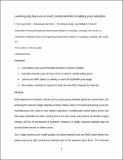Learning only buys you so much: practical limits on battery price reduction
Author(s)
Hsieh, I-Yun Lisa; Pan, Menghsuan Sam; Chiang, Yet-Ming; Green Jr, William H
DownloadAccepted version (901.7Kb)
Publisher with Creative Commons License
Publisher with Creative Commons License
Creative Commons Attribution
Alternative title
Learning only buys you so much: Practical limits on battery price reduction
Terms of use
Metadata
Show full item recordAbstract
Wide deployment of electric vehicles (EVs) would greatly facilitate global de-carbonization, but achieving the emission targets depends on future battery prices. Conventional learning curves for manufacturing costs, used in many battery projections, unrealistically predict battery prices will fall below $100/kWh by 2030, pushing EVs to hit price parity with internal combustion engine vehicles (ICEVs) in the absence of incentives. However, in reality, essential materials costs set practical lower bounds on battery prices. Our 2-stage learning curve model projects the active material costs and NMC-based Lithium-ion battery pack price with mineral and material costs as the respective price floors. The improved model predicts nickel-manganese-cobalt (NMC) battery prices will fall only to about $124/kWh by 2030 – much cheaper than today, but still too expensive to truly compete with ICEVs, due primarily to the high prices of cobalt, nickel, and lithium. Our results suggest that stabilizing raw materials prices and/or stimulating R&D activities on alternative battery chemistries will be important to achieve environmentally sustainable EV-based ground transportation at an attractive price. Keyword: Energy science; Battery technology; Energy storage; Energy economics; Electro mobility
Date issued
2019-04Department
Massachusetts Institute of Technology. Department of Chemical Engineering; Massachusetts Institute of Technology. Department of Materials Science and EngineeringJournal
Applied Energy
Publisher
Elsevier BV
Citation
Hsieh, I-Yun Lisa et al. "Learning only buys you so much: Practical limits on battery price reduction." Applied Energy, 239 (April 2019): 218-224.
Version: Author's final manuscript
ISSN
0306-2619